Edelstein-Keshet L. Mathematical Models in Biology
Подождите немного. Документ загружается.


526
Spatially
Distributed Systems
and
Partial
Differential
Equation
Models
Chemical Patterns
and
Compartments
in
Drosophila
Drosophila melanogaster,
the
common
fruitfly,
has a
number
of
distinct
life
stages
in-
cluding egg, larva, pupa,
and
adult.
In the
transition
from
egg to
larva, certain groups
of
cells
are
reserved
in the
structures known
as
imaginal discs. Specific parts
of
these
objects will eventually undergo growth
and
differentiation
to
produce adult structures.
In
the
larval tissues there
are
pairs
of
imaginal discs
for
eyes, legs, wings,
and
other
body parts. Moreover, each
of
these
may be
subdivided into groups
of
cells destined
for
specific parts
of the final
structure.
For
example,
the
wing disc
has
compartments
corresponding
to
subdivisions
of a
wing including
(1)
anterior-posterior wing parts,
(2)
dorsal-ventral wing parts,
(3)
wing-thorax wing parts,
and
others.
Based
on
experimental evidence,
it is
held that commitment
to a
given fate
is at-
tained
as a
result
of a
sequence
of
stages,
each
of
which increases
the
restrictions
on a
given
group
of
cells.
It is
possible
to map
cells (according
to
their positions
on the
wing
disc) with their eventual destinations. (See compartments
in
Figure 11.7.) Moreover,
the
sequence
of
subdivision
of the
wing discs
can
also
be
ascertained (successive
boundaries labeled
1 to 5 in the figure).
Such compartmentalization appears sponta-
neously
as the
imaginal
disc
grows.
Figure
11.7. Actual shape
and
compartmental
boundaries
of
imaginal disc
in
Drosophilia. [From Figure
5 in
Kauffman
(1977),
American Zoologist 17:631–648.]
Figure
11.8. Wave patterns
on a
disk-shaped
domain.
The
peaks
may
correspond
to
places
where
certain chemical concentrations
are
high. [From Figure
2 in
Kauffman
(1977),
American Zoologist 17:631
-648.]

Mod
for
Development
and
Pattern
Formation
in
Biological
Systems
527
On
the
basis
of
such information,
Kauffman
et. al.
(1978)
has
proposed
the
fol-
lowing
model
of
successive compartmentalization.
Identify
the
imaginal disc
of a
wing
with
an
approximate shape
of an
elliptical region. Consider
a
hypothetical reaction-dif-
fusion
system
on
this elliptical domain.
As the
domain grows
in
size,
a
discrete
se-
quence
of
chemical wave patterns
is
created. Figure 11.8 demonstrates typical wave
patterns
on
circular
or
elliptical
domains. Note
a
basic similarity
to
Figure 11.6.
The
nodal
lines
of
successive patterns that
fit on an
ellipse
as it
enlarges
are
shown
in the
sequence
in
Figure 11.9. Projecting
all five
such predicted boundaries onto
a
single
el-
lipse results
in the
compartmentalization shown
in
Figure
11.10.
This type
of
sequential process
of
compartmentalization could, then,
arise
spon-
taneously
by
virtue
of the
fact
that
an
increasing domain size [analogous
to
increasing
L
2
in the
expression
on the RHS of
(56)] causes
a
succession
of
modes
(m, n) to
appear
in
the
chemical patterns that
are
expressed.
In
this example
the
geometry
of the
domain
is
elliptical; however,
the
basic
idea
of
a
succession
of
patterns
(or
rather compartmental subdivisions)
resulting
from
a
gradual
shift
in a key
parameter
(in
this
case
the
size)
is
very
much
the
same
as
that
in
a rectangular
domain.
The
actual nodal lines
are
computed
by
solving
the
diffusion
equation
on a
circular disk.
While
there
is as yet no
direct
evidence
that
a reaction-diffusion
system
underlies
the
differentiation
of
Drosophila imaginal discs,
the
time sequence
and
geometry
of
compartmentalization proves quite suggestive
of
some underlying wave phenomenon.
Figure
11.9. Successive nodal lines
on a
growing
ellipse.
[From
Figure
3 in
Kauffman
(1977),
American Zoologist
17:631-648.]
Figure
11.10. Successive
boundaries
formed
in
the
idealized
elliptical
domain. Compare
with
the
actual compartmental boundaries
shown
in
Figure 11.7.
[From
Figure
6 in
Kauffman
(1977),
American Zoologist
17:631-648.]
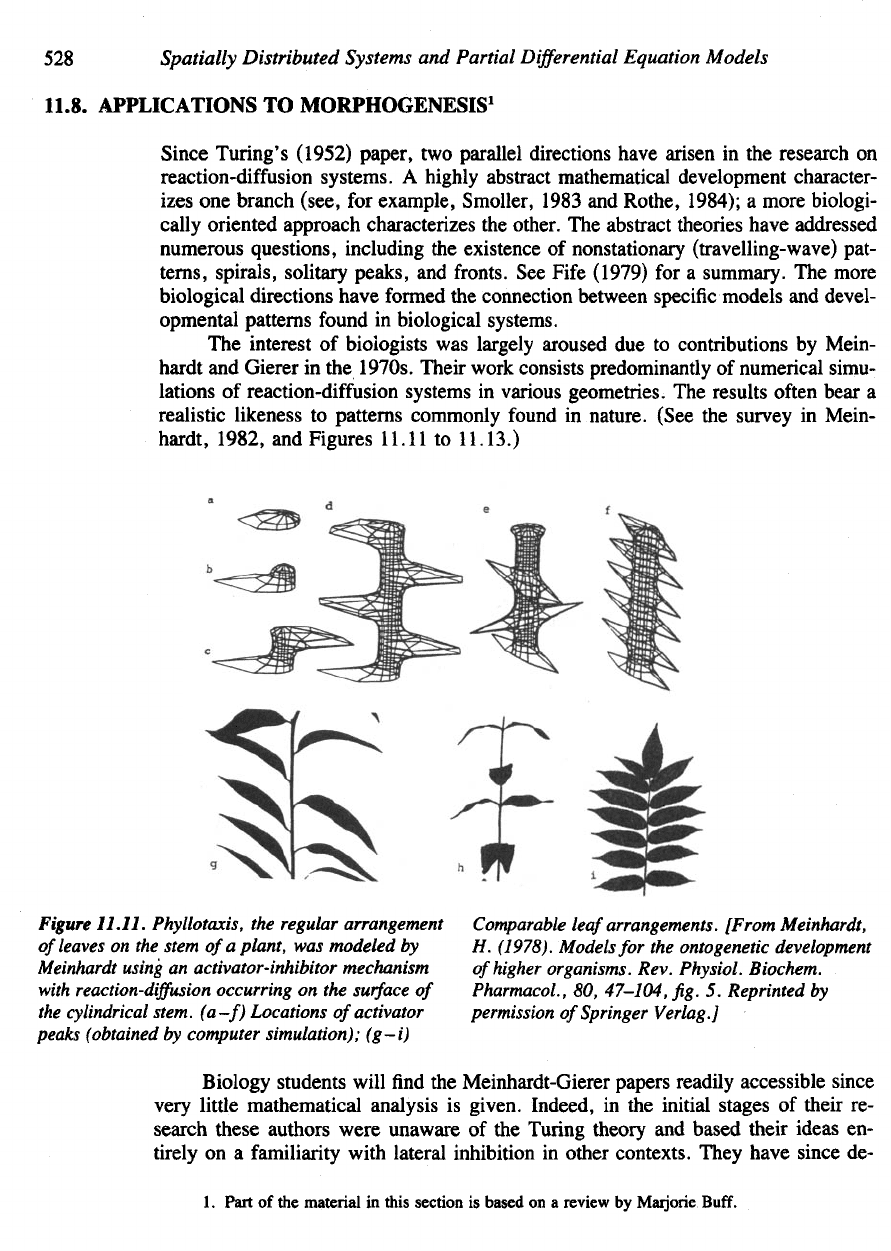
528
Spatially
Distributed Systems
and
Partial
Differential
Equation
Models
11.8. APPLICATIONS
TO
MORPHOGENESIS
1
Since
Turing's (1952) paper,
two
parallel directions hav risen
in the
research
on
reaction-diffusion
systems.
A
highly abstract mathematical development character-
izes
one
branch (see,
for
example, Smoller, 1983
and
Rothe, 1984);
a
more biologi-
cally oriented approach characterizes
the
other.
The
abstract theories have addressed
numerous questions, including
the
existence
of
nonstationary (travelling-wave) pat-
terns, spirals, solitary peaks,
and
fronts.
See
Fife
(1979)
for a
summary.
The
more
biological
directions have formed
the
connection between specific models
and
devel-
opmental patterns
found
in
biological systems.
The
interest
of
biologists
was
largely aroused
due to
contributions
by
Mein-
hardt
and
Gierer
in the
1970s.
Their work consists predominantly
of
numerical simu-
lations
of
reaction-diffusion systems
in
various geometries.
The
results
often
bear
a
realistic likeness
to
patterns commonly
found
in
nature. (See
the
survey
in
Mein-
hardt, 1982,
and
Figures 11.11
to
11.13.)
Figure
11.11. Phyllotaxis,
the
regular
arrangement
of
leaves
on the
stem
of a
plant,
was
modeled
by
Meinhardt
using
an
activator-inhibitor
mechanism
with
reaction-diffusion
occurring
on the
surface
of
the
cylindrical
stem, (a-f) Locations
of
activator
peaks
(obtained
by
computer
simulation); (g-i)
Com able
leaf
arrangements.
[From
Meinhardt,
H.
(1978).
Models
for the
ontogenetic
development
of
higher
organisms. Rev. Physiol. Biochem.
Pharmacol.,
80,
47-104,
fig. 5.
Reprinted
by
permission
of
Springer
Verlag.J
Biology students will
find the
Meinhardt-Gierer papers readily accessible since
very
little mathematical analysis
is
given. Indeed,
in the
initial stages
of
their
re-
search
these
authors were unaware
of the
Turing theory
and
based their ideas
en-
tirely
on a
familiarity with lateral inhibition
in
other contexts. They have since
de-
1.
Part
of the
material
in
this section
is
based
on a
review
by
Marjorie
Buff.
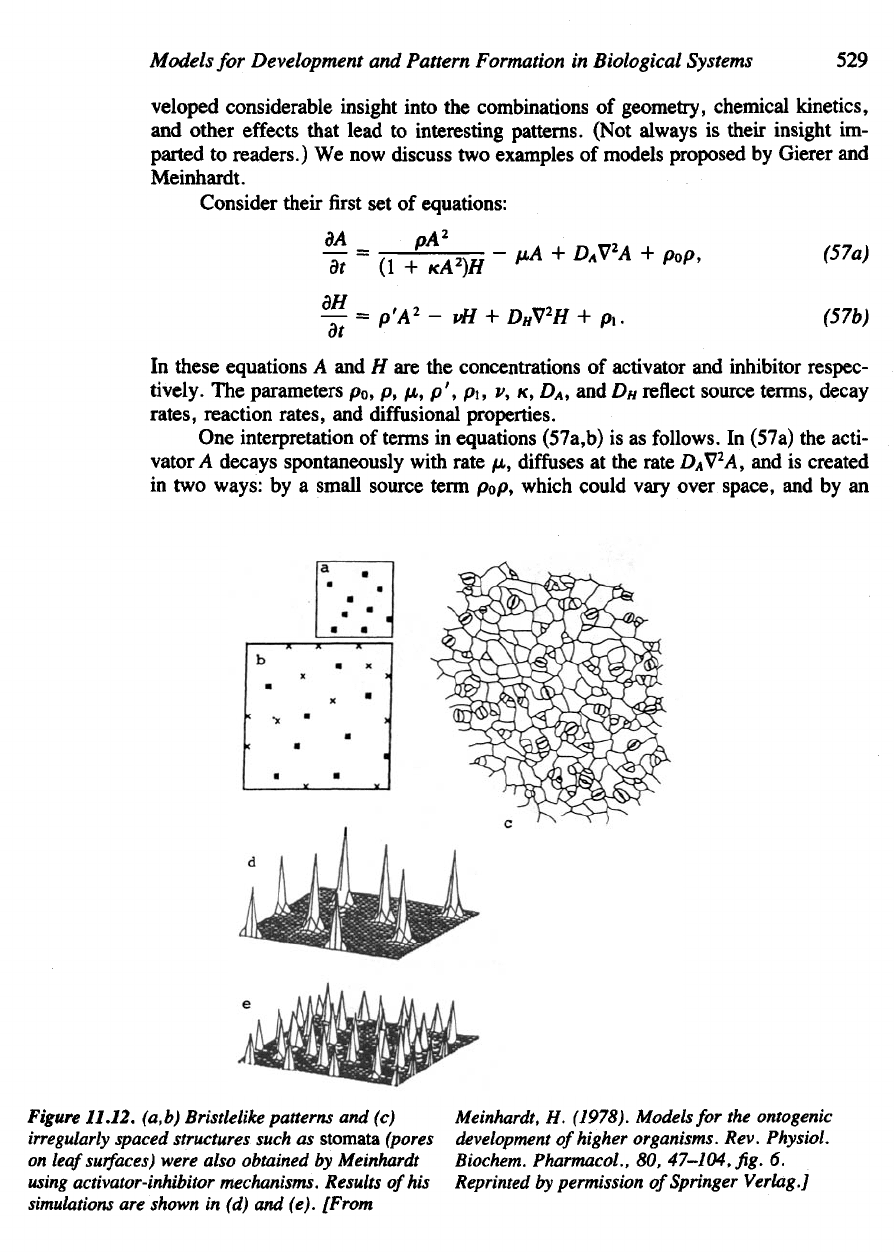
odels
for
Dev Pattern Formation
in
Biological
Systems
529
veloped
considerable insight into
the
combinations
of
geometry, chemical kinetics,
and
other effects that lead
to
interesting patterns. (Not always
is
their insight
im-
parted
to
readers.)
We now
discuss
two
examples
of
models proposed
by
Gierer
and
Meinhardt.
Consider their
first set of
equations:
In
these equations
A and H are the
concentrations
of
activator
and
inhibitor respec-
tively.
The
parameters
p
0
, p,
At,
p', pi, v, K, D
A
, and D
H
reflect
source terms, decay
rates, reaction rates,
and
diffusional
properties.
One
interpretation
of
terms
in
equations (57a,b)
is as
follows.
In
(57a)
the
acti-
vator
A
decays spontaneously with rate
/u,,
diffuses
at the
rate
£>>iV
2
A,
and is
created
in
two
ways:
by a
small source term pop, which could vary over space,
and by an
Figure
11.12.
(a,b) Bristlelike patterns
and (c)
irregularly
spaced
structures such
as
stomata
(pores
on
leaf
surfaces)
were also obtained
by
Meinhardt
using
activator-inhibitor mechanisms. Results
of
his
simulations
are
shown
in (d) and
(e). [From
Meinhardt,
H.
(1978).
Models
for the
ontogenic
development
of
higher organisms. Rev. Physiol.
Biochem. Pharmacol.,
80,
47-104,
fig. 6.
Reprinted
by
permission
of
Springer Verlag.]
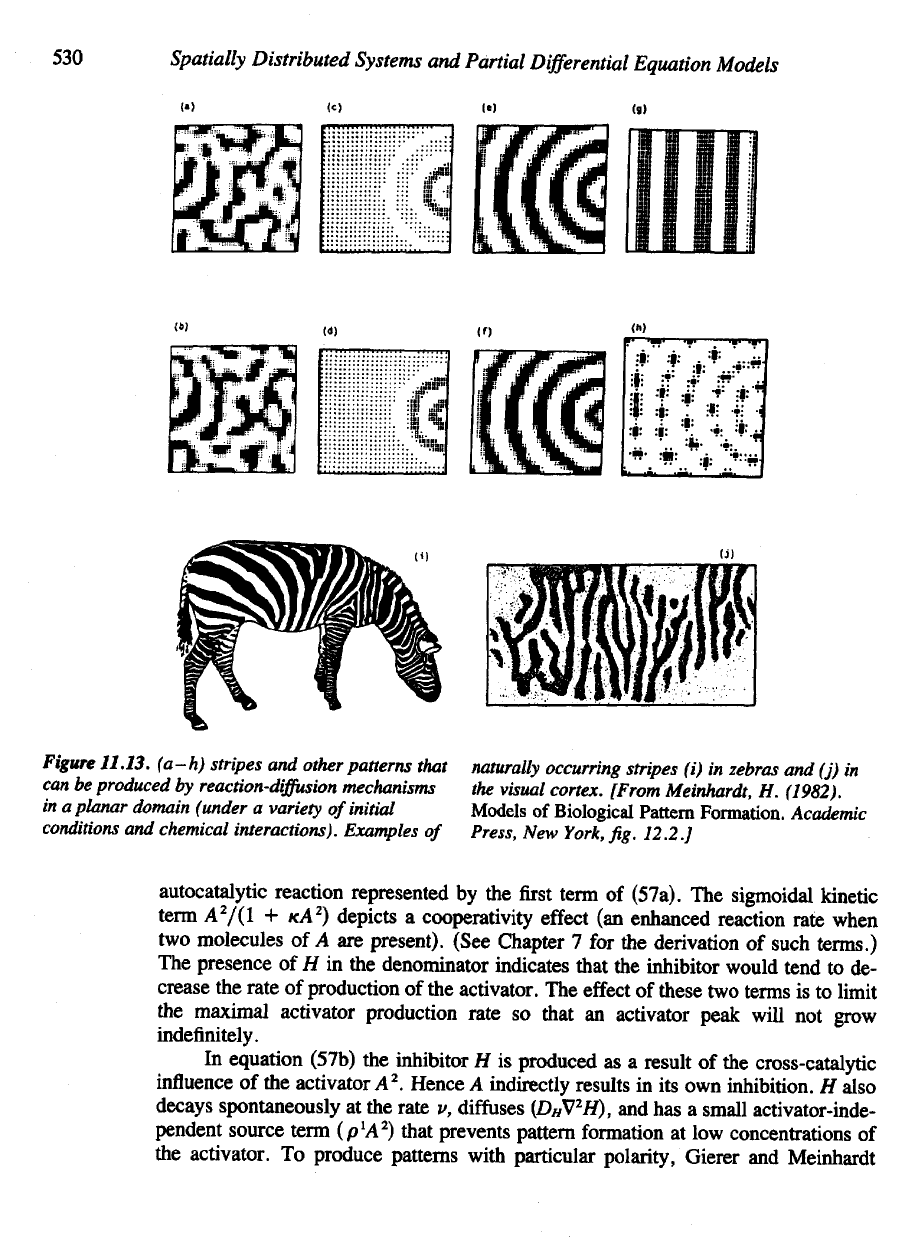
530
Spatially
Distributed
Systems
and
Partial
Differential
Equation
Models
Figure
11.13. (a-h)
stripes
and
other patterns
that
can
be
produced
by
reaction-diffusion
mechanisms
in
a
planar
domain
(under
a
variety
of
initial
conditions
and
chemical
interactions).
Examples
of
naturally
occurring
stripes
(i) in
zebras
and (j) in
the
visual
cortex.
[From
Meinhardt,
H.
(1982).
Models
of
Biological
Pattern Formation. Academic
Press,
New
York,
fig.
12.2.]
autocatalytic reaction represented
by the first
term
of
(57a).
The
sigmoidal kinetic
term
A
2
/(l
+
/cA
2
) depicts
a
cooperativity
effect
(an
enhanced reaction rate when
two
molecules
of A are
present).
(See Chapter
7 for the
derivation
of
such terms.)
The
presence
of H in the
denominator indicates that
the
inhibitor would tend
to de-
crease
the
rate
of
production
of the
activator.
The
effect
of
these
two
terms
is to
limit
the
maximal activator production rate
so
that
an
activator peak will
not
grow
indefinitely.
In
equation (57b)
the
inhibitor
H is
produced
as a
result
of the
cross-catalytic
influence
of the
activator
A
2
.
Hence
A
indirectly results
in its own
inhibition.
H
also
decays
spontaneously
at the
rate
v,
diffuses
(D
H
V
2
H),
and has a
small activator-inde-
pendent source term (p
l
A
2
) that prevents pattern formation
at low
concentrations
of
the
activator.
To
produce patterns with particular polarity, Gierer
and
Meinhardt
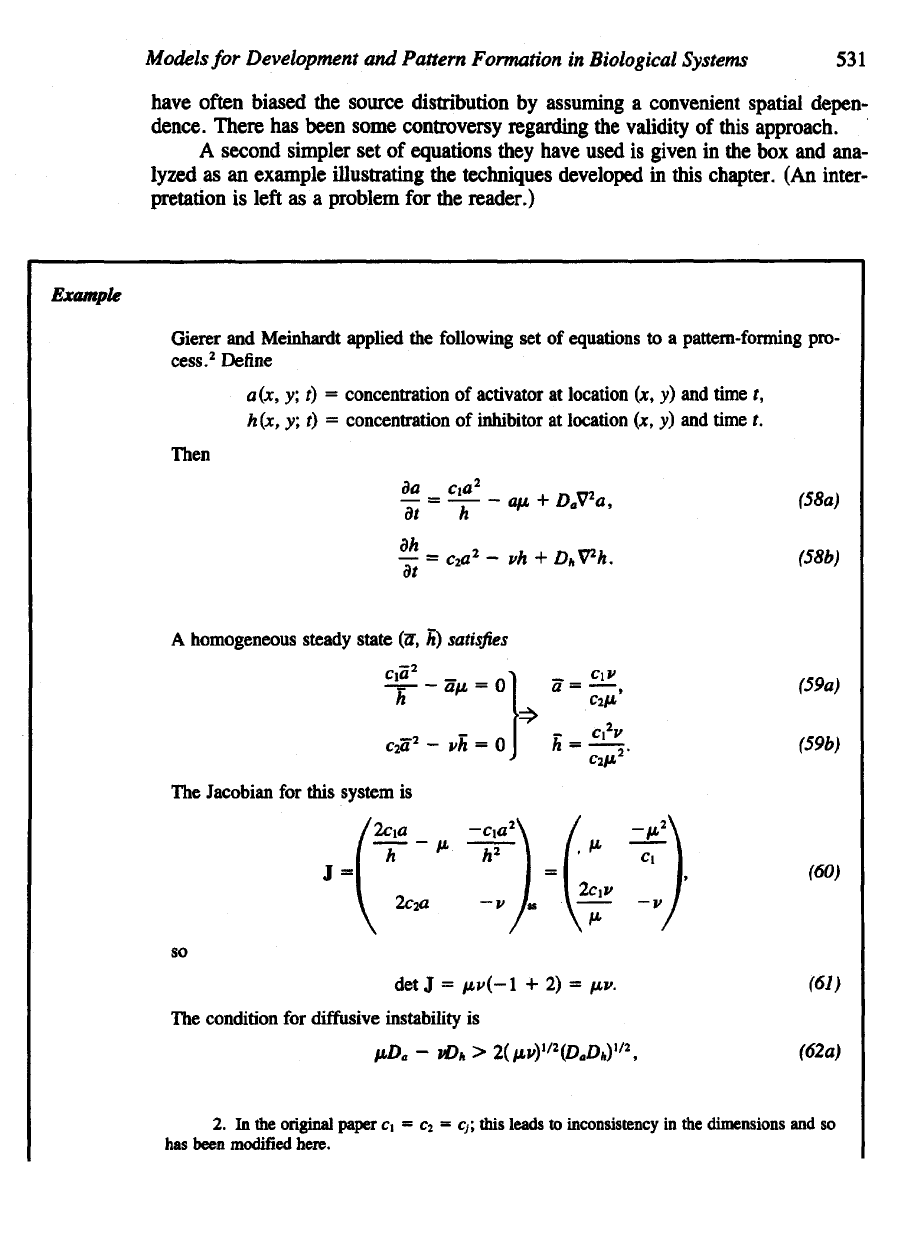
Models
for
Development
and
Pattern
Formation
in
Biological
Systems
531
have
often
biased
the
source distribution
by
assuming
a
convenient spatial depen-
dence. There
has
been some controversy regarding
the
validity
of
this
approach.
A
second simpler
set of
equations they have used
is
given
in the box and
ana-
lyzed
as an
example illustrating
the
techniques developed
in
this chapter.
(An
inter-
pretation
is
left
as a
problem
for the
reader.)
Example
Gierer
and
Meinhardt
applied
the
following
set of
equations
to a
pattern-forming
pro-
cess.
2
Define
a(x,
y, t) =
concentration
of
activator
at
location
(x, y) and
time
t,
h(x,
y; t) -
concentration
of
inhibitor
at
location
(x, y) and
time
t.
Then
A
homogeneous
steady
state
(a, h)
satisfies
The
Jacobian
for
this
system
is
The
condition
for
diffusive
instability
is
so
2. In the
original
paper
c\ = c
2
=
cy;
this leads
to
inconsistency
in the
dimensions
and so
has
been
modified
here.

532
Spatially
Distributed Systems
and
Partial
Differential
Equation
Models
where
Problem
17
shows that (62b) implies that
e5,
which must
be a
positive quantity,
satisfies
Figures 11.11 through 11.13
are a
sample
of
some
of the
elegant patterns pro-
duced over
the
years
by
Meinhardt
and
Gierer.
Unfortunately, rarely
do
they specify
the
exact conditions
and
parameter values used
in
their simulations.
It has
been
shown
(see Murray, 1982) that
the
sets
of
parameter values leading
to
pattern forma-
tion
in
these models
are
unrealistically restrictive.
Bridging
the gap
between
the
totally abstract
and the
predominantly biological
literature
are
several partly theoretical papers whose main concern
is
explaining
properties
of
patterns
on the
basis
of
chemical
interactions
and
geometric
consider-
ations. Among these
are
several classic contributions
by
Murray, including
his
model
for
animal coat patterns
briefly
highlighted here.
Murray
(1981a,&)
describes
a
hypothetical mechanism
for
melanogenesis
(synthesis
and
deposition
of
melanin granules, which
are
responsible
for the
dark
pigmentation
of
mammalian skin
and
fur).
It is
assumed that reactions
and
diffusion
occur
on the
plane
of an
active membrane
and
that
the
kinetics stem
from a
sub-
strate-inhibited enzymatic reaction between
two
substances,
5 and A
whose concen-
trations
we
represent
by s and a
(see problem 21).
In
dimensionless
form
the
model equations
are as
follows:
At
the
onset
of
instability,
the
most excitable modes
are
characterized
by
Note that
the
instability condition depends only
on
dimensionless ratio such
as e and
8,
whereas
Q
2
carries dimensions
of
(1/distance)
2
and
thus
depends
on
absolute magni-
tudes
of the
diffusion
coefficients.
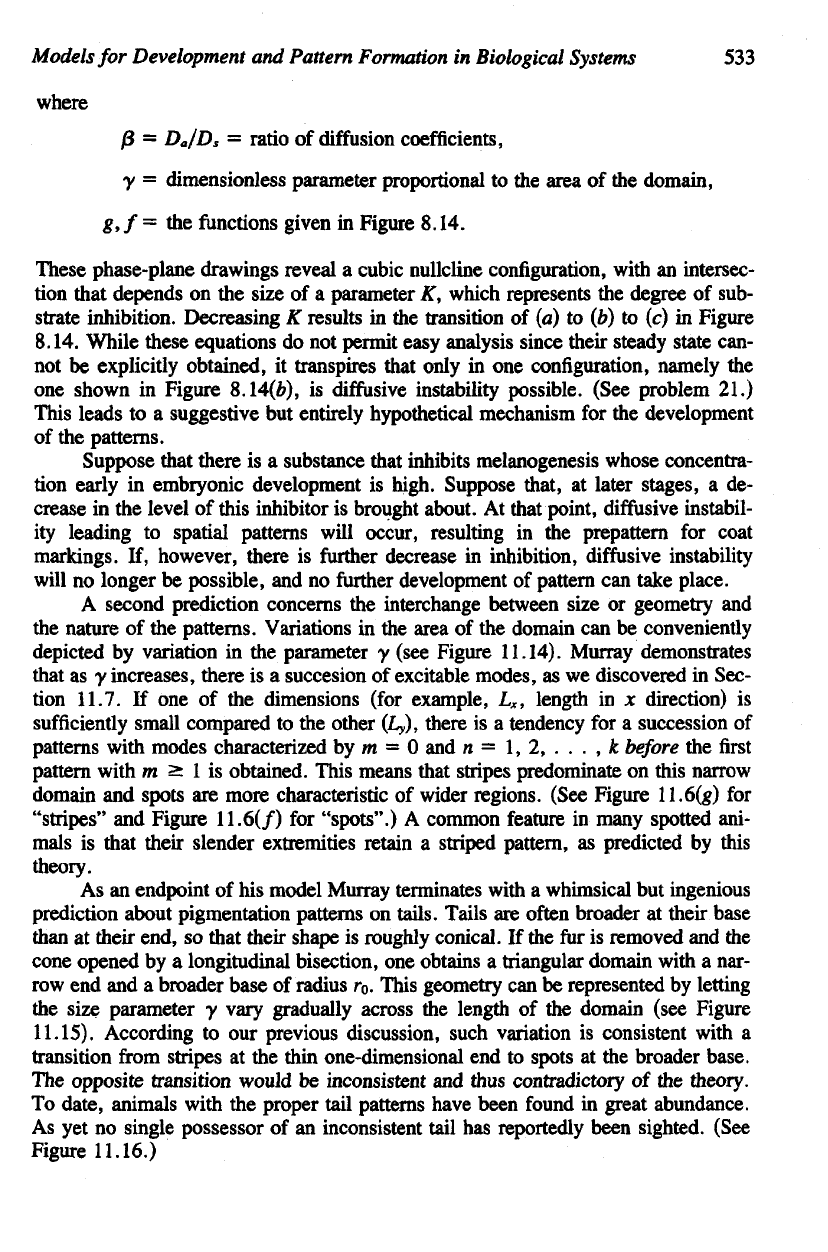
Models
for
Development
and
Pattern
Formation
in
Biological
Systems
533
where
j8
=
Da/D
s
=
ratio
of
diffusion
coefficients,
y =
dimensionless parameter proportional
to the
area
of the
domain,
g,f=
the
functions given
in
Figure 8.14.
These phase-plane drawings reveal
a
cubic
nullcline
configuration, with
an
intersec-
tion
that
depends
on the
size
of a
parameter
K,
which represents
the
degree
of
sub-
strate
inhibition. Decreasing
K
results
in the
transition
of (a) to (b) to (c) in
Figure
8.14. While these equations
do not
permit easy analysis since their steady state can-
not
be
explicitly
obtained,
it
transpires that only
in one
configuration, namely
the
one
shown
in
Figure
8.14(6),
is
diffusive
instability possible. (See problem 21.)
This leads
to a
suggestive
but
entirely hypothetical mechanism
for the
development
of
the
patterns.
Suppose that there
is a
substance that inhibits melanogenesis whose concentra-
tion
early
in
embryonic development
is
high. Suppose that,
at
later stages,
a de-
crease
in the
level
of
this inhibitor
is
brought about.
At
that point,
diffusive
instabil-
ity
leading
to
spatial patterns will occur, resulting
in the
prepattern
for
coat
markings.
If,
however, there
is
further
decrease
in
inhibition,
diffusive
instability
will
no
longer
be
possible,
and no
further
development
of
pattern
can
take place.
A
second prediction concerns
the
interchange between size
or
geometry
and
the
nature
of the
patterns. Variations
in the
area
of the
domain
can be
conveniently
depicted
by
variation
in the
parameter
y
(see Figure
11.14).
Murray demonstrates
that
as y
increases, there
is a
succesion
of
excitable modes,
as we
discovered
in
Sec-
tion
11.7.
If one of the
dimensions (for example,
L
x
,
length
in x
direction)
is
sufficiently
small compared
to the
other
(Ly),
there
is a
tendency
for a
succession
of
patterns
with modes characterized
by m = 0 and n = 1, 2, . . . , k
before
the first
pattern
with
m ^ 1 is
obtained. This means that stripes predominate
on
this narrow
domain
and
spots
are
more
characteristic
of
wider
regions.
(See Figure
11.6(g)
for
"stripes"
and
Figure
11.6(/)
for
"spots".)
A
common
feature
in
many spotted ani-
mals
is
that their slender extremities retain
a
striped pattern,
as
predicted
by
this
theory.
As
an
endpoint
of his
model Murray terminates with
a
whimsical
but
ingenious
prediction about pigmentation patterns
on
tails. Tails
are
often
broader
at
their base
than
at
their
end,
so
that their shape
is
roughly
conical.
If the fur is
removed
and the
cone opened
by a
longitudinal bisection,
one
obtains
a
triangular domain with
a
nar-
row
end and a
broader
base
of
radius
r
0
.
This geometry
can be
represented
by
letting
the
size parameter
y
vary gradually across
the
length
of the
domain (see Figure
11.15).
According
to our
previous discussion, such variation
is
consistent with
a
transition
from
stripes
at the
thin one-dimensional
end to
spots
at the
broader base.
The
opposite
transition would
be
inconsistent
and
thus contradictory
of the
theory.
To
date, animals with
the
proper tail patterns have been
found
in
great abundance.
As
yet no
single possessor
of an
inconsistent tail
has
reportedly been sighted. (See
Figure
11.16.)
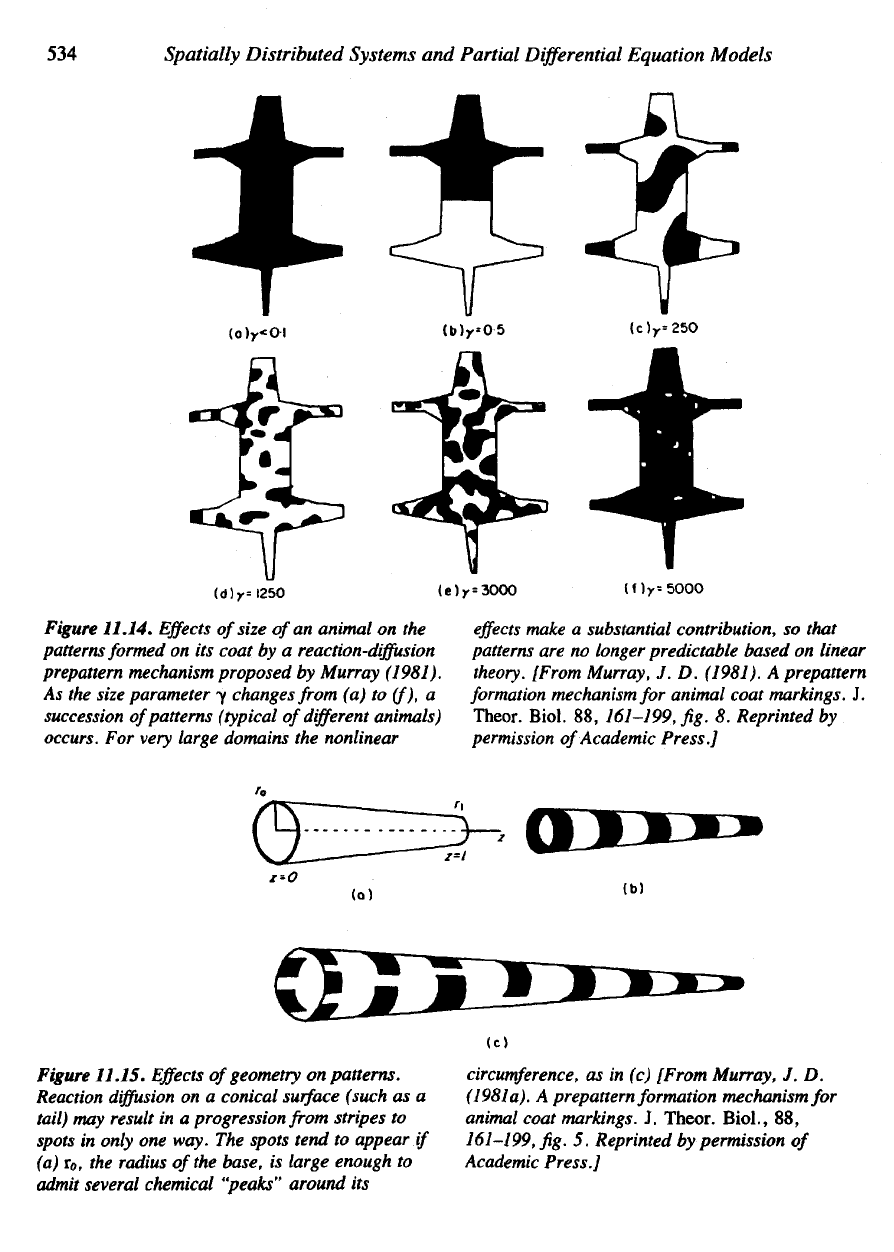
534
Spatially
Distributed Systems
and
Partial
Differential
Equation Models
Figure
11.14.
Effects
of
size
of an
animal
on the
patterns formed
on its
coat
by a
reaction-diffusion
prepattern
mechanism proposed
by
Murray (1981).
As the
size parameter
y
changes from
(a) to
(f),
a
succession
of
patterns
(typical
of
different
animals)
occurs.
For
very
large domains
the
nonlinear
effects
make
a
substantial contribution,
so
that
patterns
are no
longer predictable based
on
linear
theory.
[From Murray,
J. D.
(1981).
A
prepattern
formation
mechanism
for
animal coat markings.
J.
Theor.
Biol.
88,
161-199,
fig. 8.
Reprinted
by
permission
of
Academic Press.]
Figure
11.15.
Effects
of
geometry
on
patterns.
Reaction
diffusion
on a
conical
surface
(such
as a
tail)
may
result
in a
progression from stripes
to
spots
in
only
one
way.
The
spots tend
to
appear
if
(a)
TO,
the
radius
of the
base,
is
large enough
to
admit
several chemical "peaks" around
its
circumference,
as in (c)
[From Murray,
J. D.
(1981
a). A
prepattern formation mechanism
for
animal
coat markings.
J.
Theor.
Biol.,
88,
161-199,
fig. 5.
Reprinted
by
permission
of
Academic
Press.]
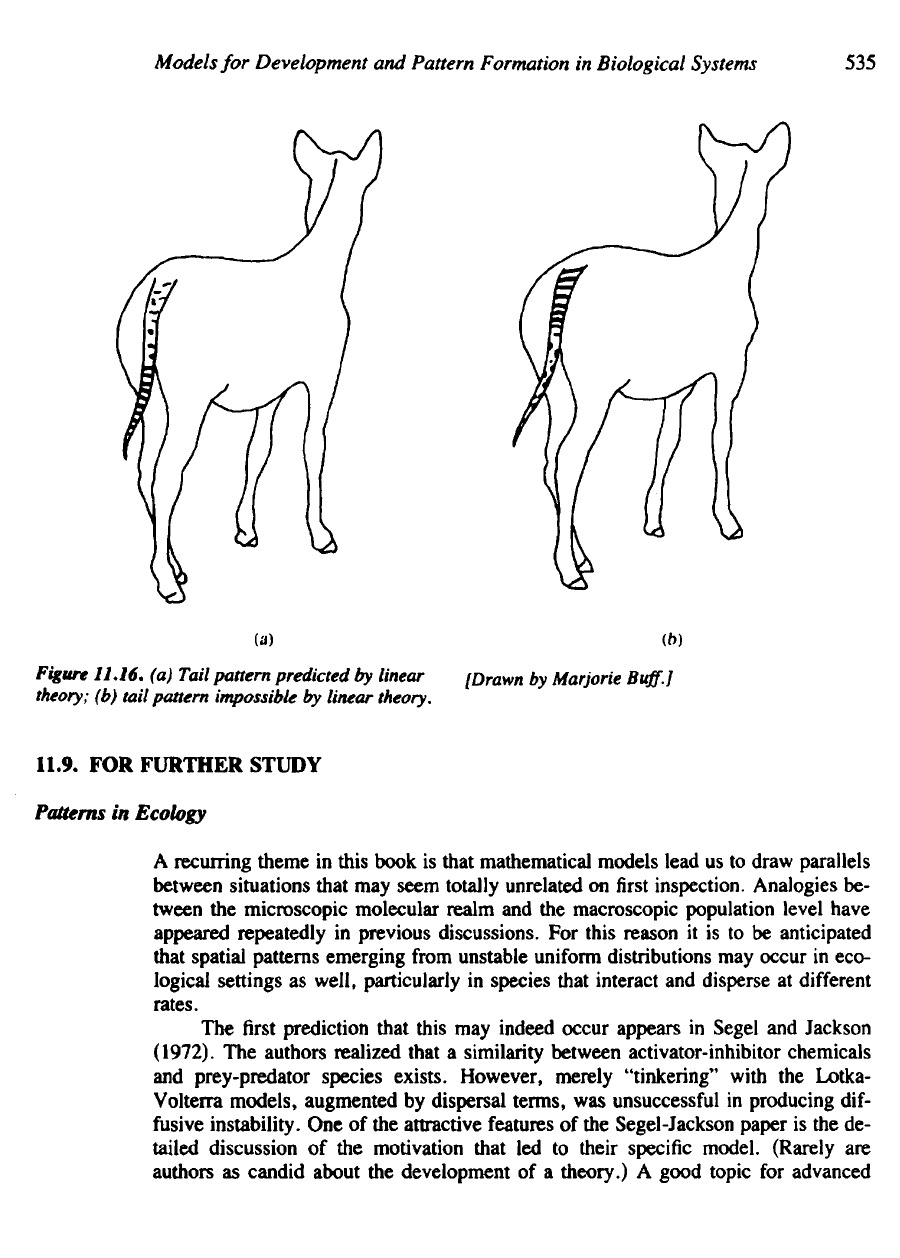
Models
for
Development
and
Pattern Formation
in
Biological
Systems
535
Figure
11.16.
(a)
Tail
pattern predicted
by
linear
theory;
(b)
tail pattern impossible
by
linear theory.
[Drawn
by
Marjorie
Buff.]
11.9.
FOR
FURTHER STUDY
Patterns
in
Ecology
A
recurring theme
in
this book
is
that mathematical models lead
us to
draw
parallels
between situations that
may
seem totally unrelated
on
first
inspection. Analogies
be-
tween
the
microscopic molecular realm
and the
macroscopic population level have
appeared repeatedly
in
previous discussions.
For
this reason
it is to be
anticipated
that
spatial patterns emerging
from
unstable
uniform
distributions
may
occur
in
eco-
logical
settings
as
well, particularly
in
species
that interact
and
disperse
at
different
rates.
The
first
prediction that this
may
indeed occur appears
in
Segel
and
Jackson
(1972).
The
authors realized that
a
similarity between activator-inhibitor chemicals
and
prey-predator
species
exists.
However, merely "tinkering"
with
the
Lotka-
Volterra models, augmented
by
dispersal terms,
was
unsuccessful
in
producing dif-
fusive
instability.
One of the
attractive features
of the
Segel-Jackson paper
is the de-
tailed
discussion
of the
motivation that
led to
their
specific
model.
(Rarely
are
authors
as
candid about
the
development
of a
theory.)
A
good topic
for
advanced
